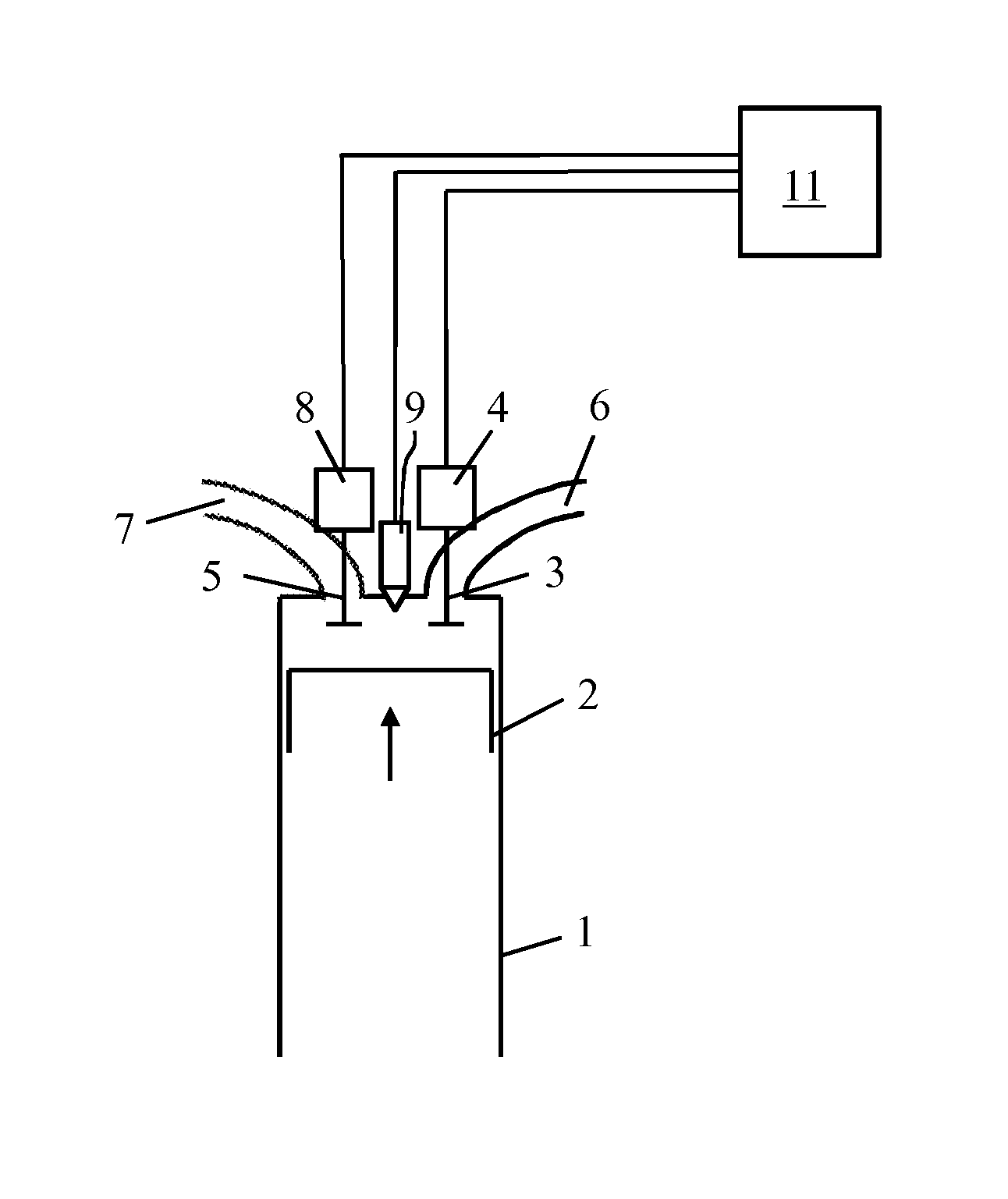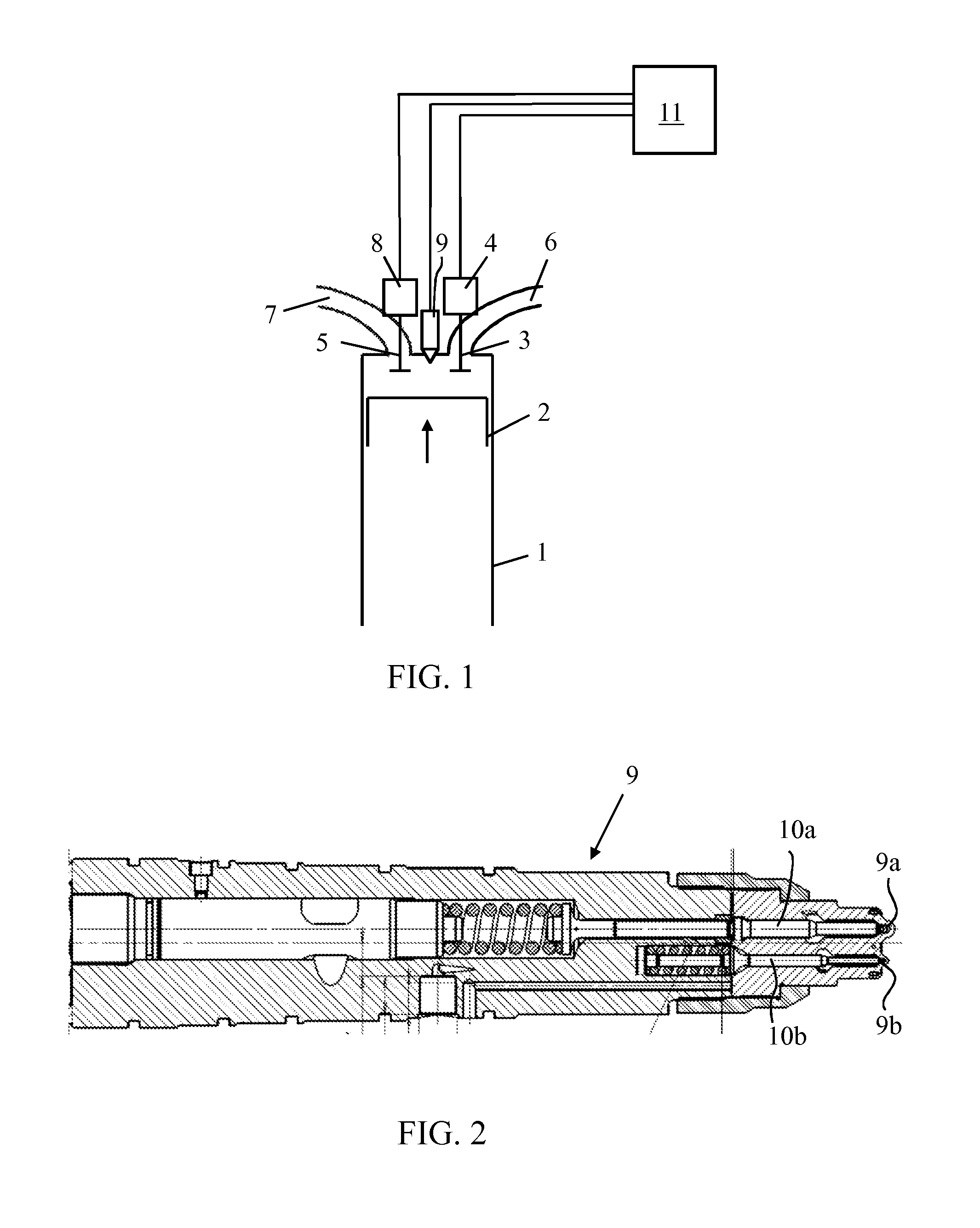Control method for an internal combustion engine and internal combustion engine
a control method and internal combustion engine technology, applied in electrical control, output power, fuel injection apparatus, etc., can solve the problems of high smoke emissions, achieve the effects of reducing nox emissions, reducing smoke emissions, and reducing emissions
- Summary
- Abstract
- Description
- Claims
- Application Information
AI Technical Summary
Benefits of technology
Problems solved by technology
Method used
Image
Examples
second embodiment
[0028]According to the invention, the method comprises a third operating mode that is used at part loads, as shown in table 2. In the embodiment of table 2, the third operating mode is used at loads that are 35-50% of the maximum load. Accordingly, the first operating mode is used at loads that are 50-100% of the maximum load, i.e. from intermediate to high loads.
TABLE 2Control strategy according to a second embodiment of the invention.Engine load0-35%35-50%50-100%2. mode3. mode1. modeValve timingNo MillerMiller cycleInjection needleSmall needleLarge needle
[0029]In the third operating mode, the Miller cycle is not used. Instead, conventional intake valve closing timing is used for achieving low smoke emissions. Fuel is injected into the cylinders 1 of the engine by using the first nozzle 9a.
third embodiment
[0030]According to the invention, the method comprises a fourth operating mode that is used at low loads, as shown in table 3. In the embodiment of table 3, the fourth operating mode is used at loads that are 15-35% of the maximum load. Accordingly, the second operating mode is used at loads that are 0-15% of the maximum load, i.e. at very low loads.
TABLE 3Control strategy according to a third embodiment of the invention.Engine load0-15%15-35%35-50%50-100%2. mode4. mode3. mode1. modeValve timingNo MillerMiller cycleInjection needleSmall needleLarge needle
[0031]In the fourth operating mode, fuel is injected into the cylinders 1 of the engine by using the second nozzle 9b for achieving low smoke emissions. The Miller cycle is used for achieving low NOx emissions.
fourth embodiment
[0032]According to the invention, the method comprises a fifth operating mode that is used at intermediate loads, as shown in table 4. In the embodiment of table 4, the fourth operating mode is used at loads that are 50-85% of the maximum load. Accordingly, the first operating mode is used at loads that are 85-100% of the maximum load, i.e. at high loads. The fifth operating mode gives low NOx emissions and SFOC at intermediate loads.
TABLE 4Control strategy according to a fourth embodiment of the invention.Engine load0-15%15-35%35-50%50-85%85-100%(very low)(low)(part)(intermediate)(high)2. mode4. mode3. mode5. mode1. modeVIC ONNo MillerInter. millerVIC OFFFull MillerVIO ONLong overlapInjection needleSmall needleLarge needle
[0033]Another difference between the embodiment of table 4 and the embodiments of tables 1-3 is that in the embodiment of table 4, the Miller cycle of the first operating mode is different from the Miller cycles of the other operating modes. In the fourth and fift...
PUM
 Login to View More
Login to View More Abstract
Description
Claims
Application Information
 Login to View More
Login to View More - R&D
- Intellectual Property
- Life Sciences
- Materials
- Tech Scout
- Unparalleled Data Quality
- Higher Quality Content
- 60% Fewer Hallucinations
Browse by: Latest US Patents, China's latest patents, Technical Efficacy Thesaurus, Application Domain, Technology Topic, Popular Technical Reports.
© 2025 PatSnap. All rights reserved.Legal|Privacy policy|Modern Slavery Act Transparency Statement|Sitemap|About US| Contact US: help@patsnap.com



